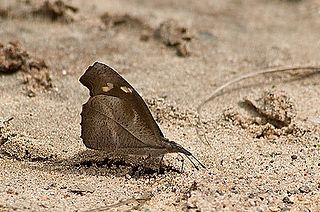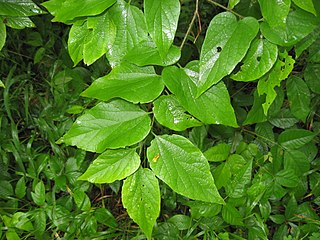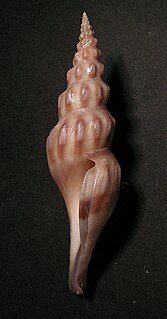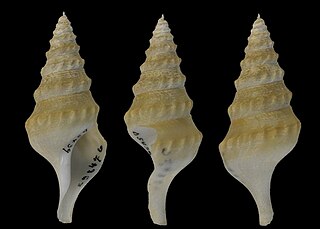
Celtis is a genus of about 60–70 species of deciduous trees, commonly known as hackberries or nettle trees, widespread in warm temperate regions of the Northern Hemisphere, in southern Europe, southern and eastern Asia, and southern and central North America, south to central Africa, and northern and central South America. The genus is present in the fossil record at least since the Miocene of Europe, and Paleocene of North America and eastern Asia.

The Luzon bleeding-heart is one of a number of species of ground dove in the genus Gallicolumba that are called "bleeding-hearts". The Luzon Bleeding-heart is the species in which the "blood" feature is most pronounced, with the reddish hue extending down the belly, furthering the illusion of blood having run down the bird's breast.

The Philippine duck is a large dabbling duck of the genus Anas. Its native name is papan. It is endemic to the Philippines. As few as 5,000 may remain. Overhunting and habitat loss has contributed to its decline.
Balakata is a genus of trees in the family Euphorbiaceae first described as a genus in 1999. It is native to Southeast Asia, southern China, the Himalayas, and New Guinea. The genus name was inspired by balákat-gúbat ("shoulder-tree"), the Philippine common name for B. luzonica.

Celtis laevigata is a medium-sized tree native to North America. Common names include sugarberry, Southern hackberry, or in the southern U.S. sugar hackberry or just hackberry.

Libythea is a widespread genus of nymphalid butterflies commonly called beaks or snouts. They are strong fliers and may even be migratory.

Celtis tenuifolia, the dwarf hackberry or Georgia hackberry is a shrub or small tree 2 to 12 meters high. It is native to eastern North America, but is very uncommon north of the Ohio River. In Canada, dwarf hackberry is designated as threatened and protected under Canada's Species at Risk Act.
Celtis balansae is a species of plant in the family Cannabaceae. It is endemic to New Caledonia.
Celtis hypoleuca is a species of plant in the family Cannabaceae. It is endemic to New Caledonia.

Celtis lindheimeri, also called Lindheimer's hackberry, is a species of tree in the family Cannabaceae. It is typically found in areas of central Texas and northeastern Mexico. It has a height averaging 9 meters, and produces a reddish-brown berry. It is a species closely related to netleaf hackberry which is common in western United States. The Spanish common name is "palo blanco", meaning "white tree", which is commonly used to identify this tree. It is named after its discoverer Ferdinand Lindheimer, a German-born botanical collector and Texas newspaper editor.
Balakata luzonica is a species of flowering plant in the family Euphorbiaceae. It is distributed from the Philippines to New Guinea.

Comitas is a genus of medium-sized sea snails, marine gastropod molluscs in the family Pseudomelatomidae.

Asterocampa celtis, the hackberry emperor, is a North American butterfly that belongs to the brushfooted butterfly family, Nymphalidae. It gets its name from the hackberry tree upon which it lays its eggs. The hackberry tree is the only host plant for A. celtis and is the food source for larvae.

Celtis sinensis is a species of flowering plant in the hemp family, Cannabaceae, that is native to slopes in East Asia.

Cannabaceae is a small family of flowering plants. As now circumscribed, the family includes about 170 species grouped in about 11 genera, including Cannabis, Humulus (hops) and Celtis (hackberries). Celtis is by far the largest genus, containing about 100 species.

Celtis reticulata, with common names including netleaf hackberry, western hackberry, Douglas hackberry, netleaf sugar hackberry, palo blanco, and acibuche, is a small- to medium-sized deciduous tree native to western North America.

Trema orientalis is a species of flowering tree in the hemp family, Cannabaceae. It is known by many common names, including charcoal-tree, Indian charcoal-tree, pigeon wood, Oriental trema, and in Hawaii, where it has become naturalized, gunpowder tree, or nalita. It has a near universal distribution in tropical and warm temperate parts of the Old World, with a range extending from South Africa, through the Middle East, the Indian subcontinent and southern China to Southeast Asia and Australia.
Phyllonorycter luzonica is a moth of the family Gracillariidae. It is known from Luzon island in the Philippines.

Gnoma luzonica is a species of beetle in the family Cerambycidae. It was described by Wilhelm Ferdinand Erichson in 1834, originally as G. luzonicum. It is known from the Philippines.

Leucosyrinx luzonica is a species of sea snail, a marine gastropod mollusk in the family Pseudomelatomidae, the turrids and allies.















